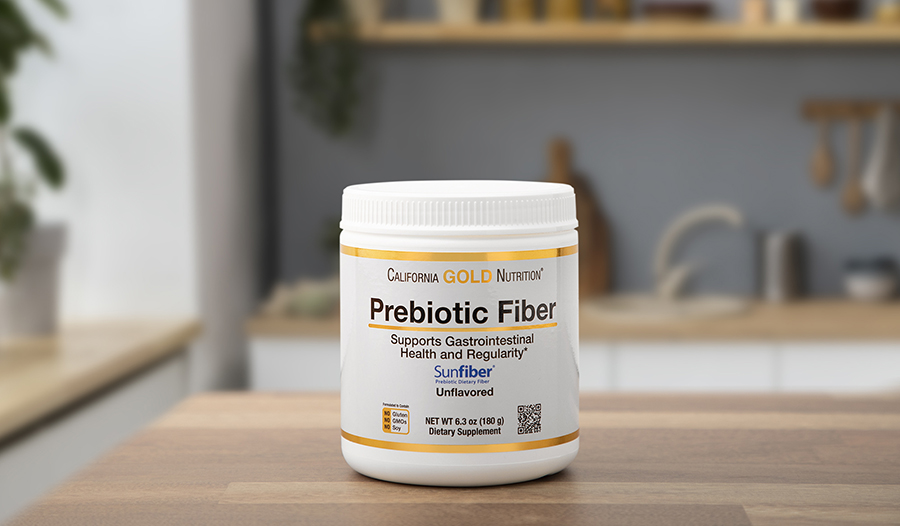Here’s Why Prebiotic Fiber Could Help Support Gastrointestinal Health

Research continues to suggest the gut microbiome—the bacteria that live throughout our digestive tract—is a key factor in physical and mental health. They play a role in digestion, nutrient production, immune function, and blood sugar regulation. Studies have linked dysregulation of the gut microbiome to numerous conditions, including obesity, autoimmune conditions, dementia, diabetes, gastrointestinal problems, and heart disease. Maintaining healthy levels of good bacteria may be critical for maintaining health over the lifespan.
While numerous factors play into and shape the gut microbiome, one of the largest is diet. Research strongly suggests that the foods that we consume, especially foods containing prebiotic fiber, may provide significant health benefits by improving and maintaining a healthy gut microbiome.
What Is Prebiotic Fiber?
While most people understand that fiber is a form of roughage that can help with digestion and regularity, not all types of fiber are created equal. Prebiotic fibers are a category of fiber that is preferentially consumed by beneficial bacteria in the gut, selectively encouraging their growth.
More specifically, prebiotic fibers are typically chains of sugars that are indigestible for humans but readily consumed by beneficial bacteria. By feeding the good bacteria throughout the digestive tract, it can help suppress the growth of other bacteria and yeast that may cause inflammation that contributes to several chronic health issues.
What Are the Different Types of Prebiotic Fibers?
Fructooligosaccharides (FOS)
There are several different prebiotic fibers, most of which have been derived from different food sources. Probably one of the most well-known prebiotics is fructooligosaccharides (FOS). FOS are short-chains of fructose found in honey, onions, chicory, Jerusalem artichokes, green banana, and other fruits and vegetables. Depending on the chain size, they are roughly half as sweet as table sugar and have found use in some natural sugar substitutes. FOS readily dissolves in water and is heat stable, making it easy to cook or bake with.
Galactooligosaccharides (GOS)
Another type of prebiotic, galactooligosaccharides (GOS) are found in human milk, as well as in onions, broccoli, beets, and some types of beans. As the name suggests, GOS is composed of chains of galactose, a simple sugar commonly occurring in milk products as a part of lactose. Lactose is a combination of two simple sugars: galactose and glucose.
Resistant Starch
The other main type of prebiotic is often referred to as resistant starch. For years it was thought that starch was completely broken down in the digestive tract, absorbed, and utilized by the human body. However, research started to identify forms of starch that were not fully broken down, These types of starch resist complete digestion. As such, these “resistant starches” are fermented in the colon, feeding beneficial bacteria and increasing their numbers.
Resistant starch content in food varies tremendously based on the ripeness and processing of a given food. Generally the more cooked or broken down the food, the less resistant starch that is present. Some of the first recognized sources of resistant starch were grain and seed kernels, green bananas, and raw potatoes. Other sources include peas, beans, and lentils.
Benefits of Prebiotic Fibers
Constipation
Research has slowly been accumulating that suggests the consumption of prebiotics, from foods or supplements, can have beneficial effects on gut flora. One of the main findings is that prebiotics can help raise levels of bifidobacteria in the colon. With these changes, stool quality and consistency often improve.
While more research is needed, prebiotics may be an effective option for some forms of constipation. A recent review concluded that, in general, prebiotics increase stool frequency and improve stool consistency. Combining prebiotics and probiotics may also yield greater gastrointestinal benefits than either treatment alone.
Heart Disease
Heart disease and stroke are the leading cause of death worldwide. In 2019, 32% of all deaths were thought to be related to heart disease or stroke. Considering the scope and scale of heart disease throughout the world, anything that can help with prevention is worth considering.
Of interest, changes in the gut microbiota are related to both acute and chronic cardiovascular (heart and blood vessel) problems. When the microbiota becomes unbalanced, inflammation can increase in both the digestive tract and throughout the body. Research demonstrates that prebiotic fibers can help to rebalance gut flora, decreasing inflammation and reducing cholesterol. These changes may be relevant for decreasing heart disease risks.
While not all fiber is considered prebiotic fiber, research on higher fiber intake in general shows reductions in death from heart disease and stroke by between 15-30%. There is also a significant reduction in the incidence of heart disease. Clinical trials have also found lower body weight and reduced blood pressure with fiber consumption, both of which can improve heart health.
Diabetes
Diabetes is rapidly becoming an epidemic throughout the world, with over 8.5% of individuals affected. Diabetes, a condition caused by poor blood sugar control, ravages the body. It is a major cause of blindness, kidney failure, heart attacks, stroke, and the amputation of the lower leg and foot. Eating a healthy diet, staying physically active, and maintaining a healthy body weight all can help reduce the incidence.
As a part of a healthy diet for diabetes, prebiotic fiber appears to provide significant benefits. A study in women with diabetes found benefits with resistant dextrin, a type of prebiotic. After two months, the women taking the prebiotic had significantly reduced their insulin resistance, insulin levels, and inflammation.
A separate, but similar trial using FOS enriched inulin as a prebiotic supplement found similar results. After two months, women on the prebiotic had reduced blood sugar levels and lower cholesterol, including a 21.7% reduction in low-density lipoprotein (LDL) cholesterol or “bad” cholesterol.
However, not all studies have been positive. A study on the prebiotic GOS did not find significant benefits from GOS supplementation in diabetic men. A recent meta-analysis exploring all the published studies on prebiotics for diabetes still confirmed that they were generally helpful. The most consistent benefits found were improvements in blood sugar, decreased bodyweight, improvements in heart disease markers, and reductions in inflammation.
Immune Function
While it should already be obvious, part of the benefits of fiber appears to come from improvements in immune function, including reductions in inflammation. However, other aspects of immune function may improve with supplementation as well.
A recent review of the research concluded that prebiotics likely decreases respiratory tract infections by around 27%. The evidence was strongest for benefits in infants and children, but still may hold relevance for adults, although more research is needed to know for sure.
The immune system effects from prebiotics appear to be related to changes in gut flora. Prebiotic fiber can change the bacteria present throughout the digestive tract. Considering the majority of the immune system is present in the gut and that friendly bacteria improve immune function, feeding these friendly bacteria with prebiotics is likely to be at least part of the reason why they affect the immune system.
In general, research has found that prebiotic fibers increase anti-inflammatory signaling while decreasing inflammatory signaling throughout the body. Prebiotics may also increase natural killer cell activity. Natural killer cells are immune cells that attack infected cells and tumor cells. They are a critical part of what is called the “innate” or nonspecific immune response.
Takeaway
Fiber is a crucial part of a healthy diet. By focusing on certain types of fiber, including prebiotic fiber, it may be possible to maximize benefits. By providing a food source for beneficial bacteria, prebiotics often complement probiotics as an approach to improve gastrointestinal and overall health. The latest data suggests that prebiotic fiber may improve constipation while reducing the risks of heart disease, diabetes, and respiratory tract infections.
References:
- Aliasgharzadeh A, Dehghan P, Gargari BP, Asghari-Jafarabadi M. Resistant dextrin, as a prebiotic, improves insulin resistance and inflammation in women with type 2 diabetes: a randomised controlled clinical trial. Br J Nutr. 2015;113(2):321-330. doi:10.1017/S0007114514003675
- Aliasgharzadeh A, Khalili M, Mirtaheri E, et al. A combination of prebiotic inulin and oligofructose improve some of cardiovascular disease risk factors in women with type 2 diabetes: a randomized controlled clinical trial. Adv Pharm Bull. 2015;5(4):507-514. doi:10.15171/apb.2015.069
- Anandharaj M, Sivasankari B, Rani RP. Effects of probiotics, prebiotics, and synbiotics on hypercholesterolemia: a review. Chin J Biol. 2014;2014 doi.org/10.1155/2014/572754
- Asp NG, van Amelsvoort JM, Hautvast JG. Nutritional implications of resistant starch. Nutr Res Rev. 1996;9(1):1-31. doi:10.1079/NRR19960004
- Colantonio AG, Werner SL, Brown M. the effects of prebiotics and substances with prebiotic properties on metabolic and inflammatory biomarkers in individuals with type 2 diabetes mellitus: a systematic review. J Acad Nutr Diet. 2020;120(4):587-607.e2. doi:10.1016/j.jand.2018.12.013
- Dahiya D, Nigam PS. The gut microbiota influenced by the intake of probiotics and functional foods with prebiotics can sustain wellness and alleviate certain ailments like gut-inflammation and colon-cancer. Microorganisms. 2022;10(3):665. Published 2022 Mar 20. doi:10.3390/microorganisms10030665
- Davani-Davari D, Negahdaripour M, Karimzadeh I, et al. Prebiotics: definition, types, sources, mechanisms, and clinical applications. Foods. 2019;8(3):92. Published 2019 Mar 9. doi:10.3390/foods8030092
- Muir JG, Rose R, Rosella O, et al. Measurement of short-chain carbohydrates in common Australian vegetables and fruits by high-performance liquid chromatography (HPLC). J Agric Food Chem. 2009;57(2):554-565. doi:10.1021/jf802700e
- Niittynen L, Kajander K, Korpela R. Galacto-oligosaccharides and bowel function. Scand J Food Nutr. 2007;51(2):62-66. doi:10.1080/17482970701414596
- Reynolds A, Mann J, Cummings J, Winter N, Mete E, Te Morenga L. Carbohydrate quality and human health: a series of systematic reviews and meta-analyses [published correction appears in Lancet. 2019 Feb 2;393(10170):406]. Lancet. 2019;393(10170):434-445. doi:10.1016/S0140-6736(18)31809-9
- Roberfroid M, Gibson GR, Hoyles L, et al. Prebiotic effects: metabolic and health benefits. Br J Nutr. 2010;104 Suppl 2:S1-S63. doi:10.1017/S0007114510003363
- Sabater-Molina M, Larqué E, Torrella F, Zamora S. Dietary fructooligosaccharides and potential benefits on health. J Physiol Biochem. 2009;65(3):315-328. doi:10.1007/BF03180584
- Shokryazdan P, Faseleh Jahromi M, Navidshad B, Liang JB. Effects of prebiotics on immune system and cytokine expression. Med Microbiol Immunol. 2017;206(1):1-9. doi:10.1007/s00430-016-0481-y
- Varesi A, Pierella E, Romeo M, et al. The Potential role of gut microbiota in Alzheimer's disease: from diagnosis to treatment. Nutrients. 2022;14(3):668. Published 2022 Feb 5. doi:10.3390/nu14030668
- Williams LM, Stoodley IL, Berthon BS, Wood LG. The effects of prebiotics, synbiotics, and short-chain fatty acids on respiratory tract infections and immune function: a systematic review and meta-analysis. Adv Nutr. 2022;13(1):167-192. doi:10.1093/advances/nmab114
- World Health Organization. Cardiovascular Diseases (CVDs). Published June 11, 2021. Accessed March 28, 2022. https://www.who.int/news-room/fact-sheets/detail/cardiovascular-diseases-(cvds)
- World Health Organization. Diabetes. Published November 10, 2021. Accessed April 1, 2022. https://www.who.int/news-room/fact-sheets/detail/diabetes
- Wu H, Chiou J. Potential benefits of probiotics and prebiotics for coronary heart disease and stroke. Nutrients. 2021;13(8):2878. Published 2021 Aug 21. doi:10.3390/nu13082878
- Yu T, Zheng YP, Tan JC, Xiong WJ, Wang Y, Lin L. effects of prebiotics and synbiotics on functional constipation. Am J Med Sci. 2017;353(3):282-292. doi:10.1016/j.amjms.2016.09.014
DISCLAIMER:This Wellness Hub does not intend to provide diagnosis...













































































 Table of Contents
Table of Contents


